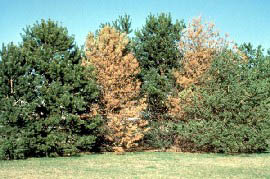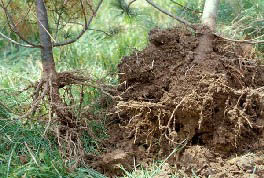Pine Wilt vs. White Pine Decline | |
|---|---|
| July 18, 2006 | |
|
Maybe you have noticed a dead mature pine standing among other, healthy-looking pines. This might appear along a highway, in a formal landscape setting, or even in a screen of trees. There are many possible causes for tree death, but what would cause only one tree to die in a group of similar pines? Even without knowing anything about plant diseases, you should be able to think of many logical explanations. Something has inhibited water movement from roots to the top of the tree, or something has occurred to the top of the tree directly. Consider what may be different about the affected tree. Look for injury to the lower trunk or roots. Consider factors that might kill roots, such as compaction, flooding, drought, chemical absorption, underground utilities, recent construction, deep planting, girdling roots, or other problems that could affect one tree and not the others. Aboveground problems that could affect this tree and not others might include a lightning strike, borers (insects), canker fungi, mechanical injury, or something specific to the site. There are two disease problems in Illinois that may cause sudden death of one of more mature pines in a setting. These often-confused diseases are pine wilt and white pine decline. Pine wilt is a disease that kills an infected pine in one season. The tree progresses from off-green to brown rather quickly. The pathogen is a nematode that lives in the aboveground plant parts and moves from tree to tree in a beetle vector. We call the disease pine wilt, but the pathogen is the pinewood nematode. The Sawyer beetle is the vector. It may feed and transmit the nematode to one or more trees before it moves on to another area of town. Because the nematode does not move to other trees by physical contact, or in water, or through root grafts, the disease often affects only one tree in a group. The following image shows two infected Scotch pines among healthy pines.  For details about pine wilt, refer to Report on Plant Disease, no. 1104, “Pine Wilt Disease,” available on the Web at http://www.ag.uiuc.edu/%7Evista/horticul.htm or in Illinois Extension offices. For details about pine wilt, refer to Report on Plant Disease, no. 1104, “Pine Wilt Disease,” available on the Web at http://www.ag.uiuc.edu/%7Evista/horticul.htm or in Illinois Extension offices. White pine decline looks like a white pine tree with pine wilt. The catch is that we have never found pine wilt on a live white pine tree. Sometimes we find the pinewood nematode in white pines that are already dead, but the nematode has not been shown to kill white pines. Pine wilt occurs on all other pines grown outdoors in Illinois. White pine decline is a complex situation mainly involving roots. Affected trees have very sparse root systems with few fine, white roots. The image shows roots from a young tree infected with white pine decline (left) and a healthy root system (right).  It is likely that several soil fungi help stress these roots, but a single pathogen has not been implicated. Affected trees have ranged in size from 2 feet to more than 20 feet, indicating that any size tree could be affected. It is likely that several soil fungi help stress these roots, but a single pathogen has not been implicated. Affected trees have ranged in size from 2 feet to more than 20 feet, indicating that any size tree could be affected.White pines are understory trees that thrive in the cool, moist, welldrained soils of Wisconsin, although they grow with intermittent success in Illinois. Many of the problem trees we have seen, at least in Illinois, have been situated on clay sites or exposed to the elements (planted in new housing developments or used as windbreaks). It is also likely that site stress has contributed to the decline of these trees. Look for more white pine problems this year. Watering helps, as does the use of natural mulch (such as shredded bark) over the root system; but without adequate root mass, plants are not able to use the available water quickly enough to replace that used by the foliage. Another factor that may be involved in Illinois is the pH of the soil. Our landscape soils have a fairly high pH level, whereas pines prefer more acidic soils. It may be helpful to fertilize with an acidic fertilizer specifically packaged for pines or acid-loving plants. Follow the directions so as not to burn the roots by applying too much fertilizer. Fertilization is usually recommended in early spring or late fall. Because white pine decline is not the result of an infectious disease, immediate removal of the tree is not necessary. Instead, try to keep the tree watered and see how it responds. Pine wilt is definitely infectious, and the only way to manage the disease is to remove an infected tree as soon as the disease is confirmed. |